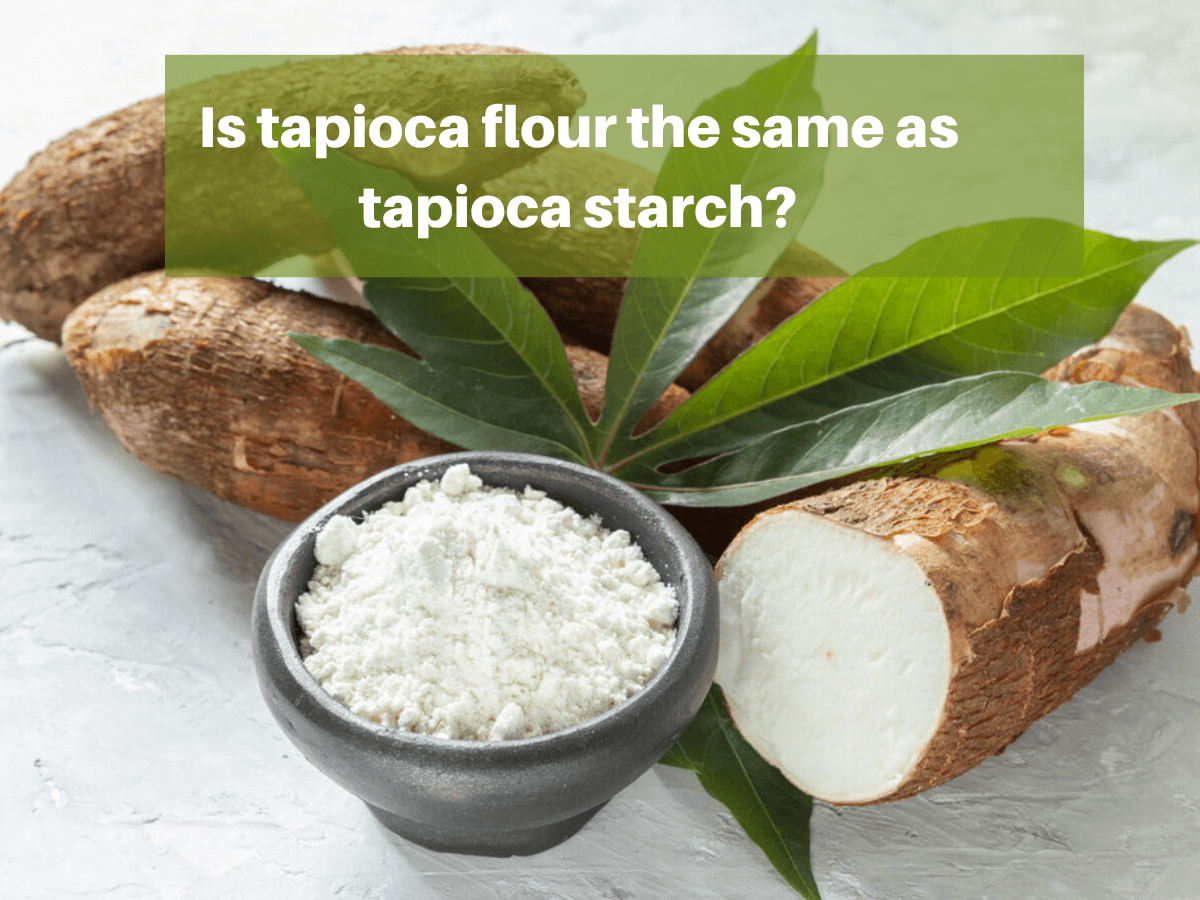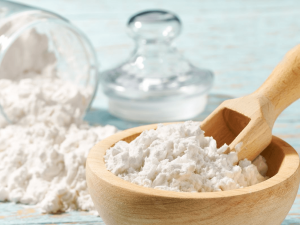Is Tapioca Flour The Same As Tapioca Starch?

Tapioca starch vs. flour? Do you believe they differ? Have you ever prepared food with them or baked with them? If so, you may be accustomed to tapioca starch. It is identical to tapioca flour. They are both identical to one another. Tapioca flour, a fine white powder similar to other starches, is helpful in gluten-free baking.
Pies, gravies, puddings, dough, and sauces can all be thickened without using cornstarch by using tapioca starch or flour instead. It helps bakes have a crisp crust and chewy texture. You will learn about many starches, including tapioca starch; this article will help you choose which one is best for your health and cooking.
Are Tapioca Starch and Tapioca Flour the Same Thing?
Tapioca Flour Vs. Tapioca Starch
Are tapioca flour and tapioca starch interchangeable terms? Whether tapioca flour and tapioca starch are interchangeable is frequently asked. So, they are identical and are both used as thickening agents in baking and cooking.
Made from the starch of the cassava plant, tapioca flour or tapioca starch is naturally gluten-free. You only need a bit in your baked goods because they are only mildly sweet and starchy. Additionally, it may be combined with other gluten-free flour, such as rice flour.
Are tapioca starch and flour the same thing? In the United States, tapioca starch and tapioca flour are interchangeable; therefore, we cannot draw any comparisons between the two. Although tapioca flour is ground up, it is the same as the tapioca pearls you would use for pudding.
Gluten-free baking gains structure thanks to tapioca flour or starch. The crunchy crust tapioca flour produces in baked items is its most attractive feature. Additionally, you can substitute tapioca flour for cornstarch 1:1 to thicken sauces, pies, soups, and other dishes.
What Is Tapioca Flour Made From?

Cassava roots are used to make tapioca flour. Because it is a starchy root vegetable, cassava is comparable to potatoes. It is a South American native that Portuguese traders brought to Africa. Later, it gained popularity throughout Asia, especially in Indonesia, Thailand, and Vietnam.
It is not a surprise that this plant is also known as “the bread of the tropics” because it is a significant source of calories and carbs. Various countries of the world today consider cassava to be a staple meal. It can be eaten whole, grated, or ground into flour. Cassava roots, however, should not be consumed uncooked as they may be harmful. It can be used to substitute flour with a nut-free, gluten-free, and grain-free powder once it has been boiled.
The Difference Between Cassava Flour and Tapioca Flour or Starch
One thing to keep in mind is that tapioca flour and cassava flour are not interchangeable terms. There are a lot of distinctions; therefore, they can’t completely replace each other. Only the starchy portion of the cassava root is used to make tapioca flour. Manufacturers use the entire root to make cassava flour.
Producers must first remove the starch from the plant’s roots to manufacture tapioca flour. They wash and pulp to complete this operation. A starchy liquid is obtained after they squeeze the moist pulp. After allowing the mixture to rest, tapioca flour or starch is left behind after the water has evaporated.
Cassava flour is created using a different method. The entire root, not only the starchy portion, is used by manufacturers. The root is peeled, allowed to dry completely, then crushed. Since no part of the root is wasted, the resulting flour contains more fibers. As a result, it is a simple gluten-free substitute for wheat flour.
But not all recipes can be made with tapioca flour instead of wheat flour. For instance, tapioca flour cannot be used to make tortillas. For such dishes, high-fiber cassava flour works best. Additionally, bear in mind that while eating cassava root raw is dangerous, eating cassava flour is not.
Uses For Tapioca Starch and Flour
Tapioca flour became a significant component of many people’s everyday diets when gluten-free baking gained popularity. In addition, boba tea drinks, which feature pearls manufactured from tapioca flour, gained popularity. This flour is tasteless and odorless, making it simple to use in various recipes.
Tapioca flour is an excellent component for both savory and sweet recipes. Due to its ability to bind, tapioca flour or starch can be used in place of gluten as a binding agent. The texture of baked items made with tapioca flour will be fluffy and airy.
Thicken The Liquids
Tapioca starch is a thickening agent when added to soups or other liquid-based dishes. Because it maintains consistency when frozen, this starch is superior to many kinds of starches.
The soup or pudding will remain creamy and thick after thawing. To make slurry flour, it is advised first to add the starch to the liquid and thoroughly mix it. To make the dish creamy and prevent the flour from clumping, you can add it later.
Use Of Tapioca Flour In Baking
Additionally, tapioca has a unique place in baking. It can produce airy, fluffy, crunchy, or chewy baked foods. Whether you want to make pie crust, bread, cookies, brownies, breakfast waffles, or other baked goods without the use of gluten, tapioca flour is a fantastic ingredient.
Nevertheless, getting the appropriate quantity is crucial. In excess, baking ingredients can give baked items a too-gummy or chewy texture. So, it’s essential to stick to the instructions.
Bubble Tea
Whether you live in the US, Europe, or Asia, you will likely notice a bubble tea shop nearby. For many people, bubble tea has become a favorite beverage. The addition of tapioca pearls enhances the pleasure and excitement of this beverage. These chewy pearls are comprised of tapioca flour and have a pearly feel.
Manufacturers start by combining flour and hot water to make tapioca dough. The dough is then divided into little balls by cutting. They extract the pearls by boiling these balls. You may also manufacture these pearls at home to go with your bubble tea concoctions, such as matcha or the traditional milk tea.
End Words By The Writer
The difference between tapioca flour and tapioca starch is minimal. The product is the same, but the container’s name depends on the manufacturers’ preferences. Making bubble tea, preparing soups, or baking items benefit from tapioca flour’s exceptional binding and thickening properties or starch. The flour can be substituted with other ingredients, such as cassava flour, cornstarch, potato starch, etc. if one cannot substitute tapioca flour at nearby stores.
FAQ’s
-
Can I substitute tapioca flour for tapioca starch?
Tapioca starch and tapioca flour are interchangeable and are the same substance. Note that with starches and flours, this is not always the case.
-
Are tapioca flour and starch the same thing?
Yes, tapioca flour and starch are interchangeable. Cassava is a tuberous plant whose root yields tapioca starch, often known as tapioca flour.
-
Why is tapioca starch bad for you?
Despite lacking critical nutrients, tapioca starch increases body weight. The majority of these are empty calories. Therefore, eating tapioca does not provide you with a significant number of nutrients; instead, it causes you to gain weight.
-
Can you use tapioca starch instead of flour?
You can substitute tapioca starch for flour when creating tapioca balls or during baking and cooking. Additionally, it is a thickening ingredient for gravies and soups.
-
What is the use of tapioca flour in baking?
Tapioca starch aids in appropriately binding the ingredients when added to baked items. A purpose for which gluten is frequently employed. The binding properties of tapioca starch enable bakers to produce baked items with a fluffy, light, and spongy texture.
-
What distinguishes tapioca flour?
In contrast to other flours, tapioca flour provides food with a shiny appearance. Additionally, it tastes nice and may be used to prepare various foods
References:
- https://www.bobsredmill.com/blog/healthy-living/what-is-it-wednesday-tapioca-flourstarch/#:~:text=It%20is%20common%20for%20tapioca,Caribbean%20and%20South%20American%20clientele.
- https://www.bobsredmill.com/blog/healthy-living/what-is-tapioca-flour-where-does-it-come-from/
- https://gfkitchenadventures.com/are-tapioca-starch-and-tapioca-flour-the-same-thing/
- http://www.differencebetween.net/object/comparisons-of-food-items/processed-foods/difference-between-tapioca-starch-and-tapioca-flour/
- https://www.healthline.com/nutrition/tapioca-flour-substitute
- https://askanydifference.com/difference-between-tapioca-starch-and-tapioca-flour/
- https://thedaringkitchen.com/tapioca-starch-vs-tapioca-flour/
- https://bonteacafe.com/tapioca-starch-vs-flour-is-there-a-difference/






